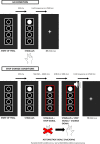Action Video Gaming and Cognitive Control: Playing First Person Shooter Games Is Associated with Improved Action Cascading but Not Inhibition
- PMID: 26655929
- PMCID: PMC4675555
- DOI: 10.1371/journal.pone.0144364
Action Video Gaming and Cognitive Control: Playing First Person Shooter Games Is Associated with Improved Action Cascading but Not Inhibition
Abstract
There is a constantly growing interest in developing efficient methods to enhance cognitive functioning and/or to ameliorate cognitive deficits. One particular line of research focuses on the possibly cognitive enhancing effects that action video game (AVG) playing may have on game players. Interestingly, AVGs, especially first person shooter games, require gamers to develop different action control strategies to rapidly react to fast moving visual and auditory stimuli, and to flexibly adapt their behaviour to the ever-changing context. This study investigated whether and to what extent experience with such videogames is associated with enhanced performance on cognitive control tasks that require similar abilities. Experienced action videogame-players (AVGPs) and individuals with little to no videogame experience (NVGPs) performed a stop-change paradigm that provides a relatively well-established diagnostic measure of action cascading and response inhibition. Replicating previous findings, AVGPs showed higher efficiency in response execution, but not improved response inhibition (i.e. inhibitory control), as compared to NVGPs. More importantly, compared to NVGPs, AVGPs showed enhanced action cascading processes when an interruption (stop) and a change towards an alternative response were required simultaneously, as well as when such a change had to occur after the completion of the stop process. Our findings suggest that playing AVGs is associated with enhanced action cascading and multi-component behaviour without affecting inhibitory control.
Conflict of interest statement
Figures

References
-
- Botvinick MM, Braver TS, Barch DM, Carter CS, Cohen JD. Conflict monitoring and cognitive control. Psychol Rev. 2001;108: 624 - PubMed
-
- Konrad K, Gauggel S, Manz A, Scholl M. Lack of inhibition: a motivational deficit in children with attention deficit/hyperactivity disorder and children with traumatic brain injury. Child Neuropsychol. 200;6: 286–296. - PubMed
-
- Konrad K, Gauggel S, Manz A, Scholl M. Inhibitory control in children with traumatic brain injury (TBI) and children with attention deficit/hyperactivity disorder (ADHD). Brain Inj. 2000;14: 859–875. - PubMed
-
- Chamberlain SR, Fineberg NA, Blackwell AD, Robbins TW, Sahakian BJ. Motor inhibition and cognitive flexibility in obsessive-compulsive disorder and trichotillomania. Am J Psychiatry. 2006;163: 1282–1284. - PubMed
Publication types
MeSH terms
LinkOut - more resources
Full Text Sources
Other Literature Sources

